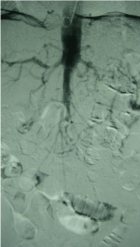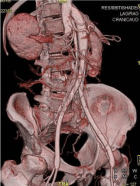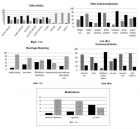Abstract
Mini Review
Severe aorto-iliac occlusive disease: Options beyond standard aorto-bifemoral bypass
Konstantinos Filis*, Constantinos Zarmakoupis, Fragiska Sigala and George Galyfos
Published: 27 December, 2018 | Volume 2 - Issue 1 | Pages: 020-024
According to recent guidelines, endovascular angioplasty is the standard treatment for TASC A and B primary aorto-iliac occlusive (AIOD) disease, and the first-line approach for TASC C lesions [1,2]. Extended TASC D occlusive disease is usually treated by open surgery yielding excellent patency rates at a cost of a higher mortality (2%-4%) and a severe morbidity (up to 10%) [3]. However, several studies have reported promising results after endovascular treatment of extensive AIOD and full reconstruction of the aortic bifurcation [4,5]. In a recent meta-analysis, Jongkind et al., concluded that endovascular treatment of extensive AIOD can be performed successfully by experienced interventionists in selected patients [6]. Although primary patency rates seem to be lower than those reported for surgical revascularization, reinterventions can often be performed percutaneously yielding a secondary patency comparable to surgical repair.
Read Full Article HTML DOI: 10.29328/journal.avm.1001006 Cite this Article Read Full Article PDF
References
- Wressnegger A, Kinstner C, Funovics M. Treatment of the aorto-iliac segment in complex lower extremity arterial occlusive disease. J Cardiovasc Surg (Torino). 2015; 56: 73-79. Ref.: https://goo.gl/77uqTK
- Aggarwal V, Waldo SW, Armstrong EJ. Endovascular revascularization for aortoiliac atherosclerotic disease. Vasc Health Risk Manag. 2016; 12: 117-127. Ref.: https://goo.gl/Eb9Fvr
- Indes JE, Pfaff MJ, Farrokhyar F, Brown H, Hashim P, et al. Clinical outcomes of 5358 patients undergoing direct open bypass or endovascular treatment for aortoiliac occlusive disease: a systematic review and meta-analysis. J Endovasc Ther. 2013; 20: 443-455. Ref.: https://goo.gl/qYWV1N
- Krankenberg H, Schlüter M, Schwencke C, Walter D, Pascotto A, et al. Endovascular reconstruction of the aortic bifurcation in patients with Leriche syndrome. Clin Res Cardiol. 2009; 98: 657-664. Ref.: https://goo.gl/9TDU6u
- Mangialardi N, Ronchey S, Serrao E, Fazzini S, Alberti V, et al. Endovascular management of total juxtarenal aortic occlusive disease in high-risk patients: technical considerations and clinical outcome. J Cardiovasc Surg (Torino). 2017; 58: 422-430. Ref.: https://goo.gl/SRk6j3
- Jongkind V, Akkersdijk GJ, Yeung KK, Wisselink W. A systematic review of endovascular treatment of extensive aortoiliac occlusive disease. J Vasc Surg. 2010; 52: 1376-1383. Ref.: https://goo.gl/eJ37NF
- Verma H, Baliga K, George RK, Tripathi RK. Surgical and endovascular treatment of occlusive aortic syndromes. J Cardiovasc Surg (Torino). 2013; 54(1 Suppl 1): 55-69. Ref.: https://goo.gl/nmCpHc
- Kim SM, Jung IM, Han A, Min SI, Lee T, et al. Surgical treatment of middle aortic syndrome with Takayasu arteritis or midaortic dysplastic syndrome. Eur J Vasc Endovasc Surg. 2015; 50: 206-212. Ref.: https://goo.gl/uCKLHh
- Pranteda C, Menna D, Capoccia L, Sirignano P, Mansour W, et al. Simultaneous Open Surgical Treatment of Aortic Coral Reef and Leriche Syndrome: Case Report and Literature Review. Ann Vasc Surg. 2016; 32: 133. e1-5. Ref.: https://goo.gl/ea8892
- Illuminati G, Calio FG, Mangialardi N, Bertagni A, Vietri F, et al. Results of axillofemoral by-passes for aorto-iliac occlusive disease. Langenbecks Arch Chir. 1996; 381: 212-217. Ref.: https://goo.gl/fk2ECG
- Chiu KW, Davies RS, Nightingale PG, Bradbury AW, Adam DJ. Review of direct anatomical open surgical management of atherosclerotic aorto-iliac occlusive disease. Eur J Vasc Endovasc Surg. 2010; 39: 460-471. Ref.: https://goo.gl/QM4txW
- Chen TW, Huang CY, Chen PL, Lee CY, Shih CC, et al. Endovascular and Hybrid Revascularization for Complicated Aorto-Iliac Occlusive Disease: Short-Term Results in Single Institute Experience. Acta Cardiol Sin. 2018; 34: 313-320. Ref.: https://goo.gl/1dHHAa
- Styczynski G, Szmigielski C, Leszczynski J, Kuch-Wocial A, Szulc M. Abdominal aortic Doppler waveform in patients with aorto-iliac disease. Eur J Vasc Endovasc Surg. 2010; 39: 714-718. Ref.: https://goo.gl/vwp2ih
- Lowery AJ, Hynes N, Manning BJ, Mahendran M, Tawfik S, et al. A prospective feasibility study of duplex ultrasound arterial mapping, digital-subtraction angiography, and magnetic resonance angiography in management of critical lower limb ischemia by endovascular revascularization. Ann Vasc Surg. 2007; 21: 443-451. Ref.: https://goo.gl/Qo79FA
- Rosen RJ, Roven SJ, Taylor RF, Imparato AM, Riles TS. Evaluation of aorto-iliac occlusive disease by intravenous digital subtraction angiography. Radiology. 1983; 148: 7-8. Ref.: https://goo.gl/dZ1Wbg
- Mesurolle B, Qanadli SD, El Hajjam M, Goeau-Brissonnière OA, Mignon F, et al. Occlusive arterial disease of abdominal aorta and lower extremities: comparison of helical CT angiography with transcatheter angiography. Clin Imaging. 2004; 28: 252-260. Ref.: https://goo.gl/h9VXbn
- Krug B, Kugel H, Harnischmacher U, Heindel W, Fischbach R, et al. Diagnostic performance of digital subtraction angiography (DSA) and magnetic resonance angiography (MRA): preliminary results in vascular occlusive disease of the abdominal and lower-extremity arteries. Eur J Radiol. 1995; 19: 77-85. Ref.: https://goo.gl/HgWUSK
- Akinwande O, Ahmad A, Ahmad S, Coldwell D. Review of pelvic collateral pathways in aorto-iliac occlusive disease: demonstration by CT angiography. Acta Radiol. 2015; 56: 419-427. Ref.: https://goo.gl/2KqXCT
- Galyfos G, Filis K. Is the revised cardiac risk index the right risk index for vascular surgery patients? Crit Care Med. 2014; 42: e631-632. Ref.: https://goo.gl/LyUrp2
- Van Damme H, Piérard L, Gillain D, Benoit T, Rigo P, et al. Cardiac risk assessment before vascular surgery: a prospective study comparing clinical evaluation, dobutamine stress echocardiography, and dobutamine Tc-99m sestamibi tomoscintigraphy. Cardiovasc Surg. 1997; 5: 54-64. Ref.: https://goo.gl/gEi1bG
- Jun HJ. Experiences of Surgical Treatment for Juxtarenal Aortic Occlusion. Vasc Specialist Int. 2014; 30: 19-25. Ref.: https://goo.gl/QH9neu
- Yang SS, Kim YW, Park YJ, Kim DI, Woo SY, et al. Results of Open Surgical Repair of Chronic Juxtarenal Aortic Occlusion. Vasc Specialist Int. 2014; 30: 81-86. Ref.: https://goo.gl/tq9Wr5
- Galyfos G, Sigala F, Basigos G, Karantzikos G, Katsaragakis S, et al. Hybrid Treatment of an Abdominal Aortic Aneurysm with Severe Calcification of the Neck and Aortic Bifurcation. Ann Vasc Surg. 2016; 36: 294.e7-294.e11. Ref.: https://goo.gl/MPoczn
- Papadimitriou D, Mayer D, Lachat M, Pecoraro F, Frauenfelder T, et al. A clampless and sutureless aortic anastomosis technique using an endograft connector for aortoiliac occlusive disease in which the aorta cannot be clamped or sewn due to calcification or scarring. Vascular. 2012; 20: 262-267. Ref.: https://goo.gl/iCvUoD
- Suzuki K, Mizutani Y, Soga Y, Iida O, Kawasaki D, et al. Efficacy and Safety of Endovascular Therapy for Aortoiliac TASC D Lesions. Angiology. 2017; 68: 67-73. Ref.: https://goo.gl/kR8GXH
- Sixt S, Krankenberg H, Möhrle C, Kaspar M, Tübler T, et al. Endovascular treatment for extensive aortoiliac artery reconstruction: a single-center experience based on 1712 interventions. J Endovasc Ther. 2013; 20: 64-73. Ref.: https://goo.gl/cs7dwv
- Panaretou V, Toufektzian L, Siafaka I, Kouroukli I, Sigala F, et al. Postoperative pulmonary function after abdominal aortic aneurysm repair in patients with chronic obstructive pulmonary disease: epidural versus intravenous analgesia. Ann Vasc Surg. 2012; 26: 149-155. Ref.: https://goo.gl/NnqiBU
- Galyfos G, Sianou A, Filis K. Pleiotropic effects of statins in the perioperative setting. Ann Card Anaesth. 2017; 20(Supplement): S43-S48. Ref.: https://goo.gl/zzu1Gd
- Galyfos G, Filis K, Sigala F, Geropapas G. Beta-blockers in vascular surgery patients: is the debate still going on? J Anesth. 2016; 30:1031-1036. Ref.: https://goo.gl/yV6ovp
- Filis K, Tsioufis C, Sianou A, Triantafillou K, Sigala F, et al. Critical evaluation on proper antithrombotic treatment in different groups of patients undergoing vascular surgery. Hellenic J Cardiol. 2018 30. pii: S1109-9666(18)30071-X. Ref.: https://goo.gl/NuvapQ
- San Norberto, E, Carrera S, Tyalor J, Vaquero C. Thirty years with a chronic aortic occlusion. J Vasc Surg 2013; 57: 1128. Ref.: https://goo.gl/VpH25T
Figures:

Figure 1

Figure 2

Figure 3
Similar Articles
-
The Impact of a Single Apheretic Procedure on Endothelial Function Assessed by Peripheral Arterial Tonometry and Endothelial Progenitor CellsGabriele Cioni*,Francesca Cesari,Rossella Marcucci,Anna Maria Gori,Lucia Mannini,Agatina Alessandrello Liotta,Elena Sticchi,Ilaria Romagnuolo,Rosanna Abbate,Giovanna D’Alessandri. The Impact of a Single Apheretic Procedure on Endothelial Function Assessed by Peripheral Arterial Tonometry and Endothelial Progenitor Cells. . 2017 doi: 10.29328/journal.hjvsm.1001001; 1: 001-007
-
Hepato-Pulmonary syndrome and Porto-Pulmonary Hypertension: Rare combination cause of Hypoxemia in patient with end-stage renal failure on Hemodialysis and hepatitis C Induced Decompensated CirrhosisAwad Magbri*,Mariam El-Magbri,Eussera El-Magbri. Hepato-Pulmonary syndrome and Porto-Pulmonary Hypertension: Rare combination cause of Hypoxemia in patient with end-stage renal failure on Hemodialysis and hepatitis C Induced Decompensated Cirrhosis. . 2017 doi: 10.29328/journal.avm.1001002; 1: 008-012
-
Management of Popliteal Artery aneurysms: Experience in our centerMichiels Thirsa,Vleeschauwer De Philippe*. Management of Popliteal Artery aneurysms: Experience in our center. . 2018 doi: 10.29328/journal.avm.1001003; 2: 001-009
-
Cystic adventitial disease of the external iliac artery with disabling claudication: A case report and short reviewNalaka Gunawansa*. Cystic adventitial disease of the external iliac artery with disabling claudication: A case report and short review. . 2018 doi: 10.29328/journal.avm.1001004; 2: 010-013
-
Anesthetic considerations for endovascular repair of ruptured abdominal aortic aneurysmsKH Kevin Luk*,Koichiro Nandate. Anesthetic considerations for endovascular repair of ruptured abdominal aortic aneurysms. . 2018 doi: 10.29328/journal.avm.1001005; 2: 014-019
-
Severe aorto-iliac occlusive disease: Options beyond standard aorto-bifemoral bypassKonstantinos Filis*,Constantinos Zarmakoupis,Fragiska Sigala,George Galyfos . Severe aorto-iliac occlusive disease: Options beyond standard aorto-bifemoral bypass. . 2018 doi: 10.29328/journal.avm.1001006; 2: 020-024
-
Navigation in the land of ScarcityAwad Magbri*,Mariam El-Magbri. Navigation in the land of Scarcity. . 2018 doi: 10.29328/journal.avm.1001007; 2: 025-026
-
Transcatheter embolization of congenital vascular malformations, single center experienceMohammed Habib*,Majed Alshounat. Transcatheter embolization of congenital vascular malformations, single center experience. . 2019 doi: 10.29328/journal.avm.1001008; 3: 001-006
-
A fatal portal vein thrombosis: A case reportM Kechida*,W Ben Yahia,W Mnari. A fatal portal vein thrombosis: A case report. . 2019 doi: 10.29328/journal.avm.1001009; 3: 007-008
-
PR and QT intervals short on the same electrocardiogramFrancisco R Breijo-Márquez*. PR and QT intervals short on the same electrocardiogram. . 2020 doi: 10.29328/journal.avm.1001010; 4: 001-004
Recently Viewed
-
Menstrual Taboos and Child Rights: Death of a Girl during MenarcheVishadha Perera*. Menstrual Taboos and Child Rights: Death of a Girl during Menarche. J Forensic Sci Res. 2025: doi: 10.29328/journal.jfsr.1001080; 9: 050-053
-
The Effect of Cellulose Fiber on the Bending Strength of Autoclaved Aerated ConcreteSvitlana Lapovska, Nicholas Chernenko, Mykola Konoplya. The Effect of Cellulose Fiber on the Bending Strength of Autoclaved Aerated Concrete. Ann Civil Environ Eng. 2024: doi: 10.29328/journal.acee.1001065; 8: 045-047
-
Evaluation of Performance Research Nuclear Reactors' Steady-state and Kinetic Model AnalysesEsraa Fareed Saeed*. Evaluation of Performance Research Nuclear Reactors' Steady-state and Kinetic Model Analyses. Ann Civil Environ Eng. 2024: doi: 10.29328/journal.acee.1001064; 8: 039-044
-
Accidents at Waste Storage Facilities: Methods of Struggle with the Consequences of AccidentsE Argal*. Accidents at Waste Storage Facilities: Methods of Struggle with the Consequences of Accidents. Ann Civil Environ Eng. 2024: doi: 10.29328/journal.acee.1001063; 8: 032-038
-
Comparative characterization between autologous serum and platelet lysate under different temperatures and storage timesCamilo Osorio Florez*, Luis Campos, Jessica Guerra, Henrique Carneiro, Leandro Abreu, Andres Ortega, Fabiola Paes, Priscila Fantini, Renata de Pino Albuquerque Maranhão. Comparative characterization between autologous serum and platelet lysate under different temperatures and storage times. Insights Vet Sci. 2023: doi: 10.29328/journal.ivs.1001038; 7: 001-009
Most Viewed
-
Feasibility study of magnetic sensing for detecting single-neuron action potentialsDenis Tonini,Kai Wu,Renata Saha,Jian-Ping Wang*. Feasibility study of magnetic sensing for detecting single-neuron action potentials. Ann Biomed Sci Eng. 2022 doi: 10.29328/journal.abse.1001018; 6: 019-029
-
Evaluation of In vitro and Ex vivo Models for Studying the Effectiveness of Vaginal Drug Systems in Controlling Microbe Infections: A Systematic ReviewMohammad Hossein Karami*, Majid Abdouss*, Mandana Karami. Evaluation of In vitro and Ex vivo Models for Studying the Effectiveness of Vaginal Drug Systems in Controlling Microbe Infections: A Systematic Review. Clin J Obstet Gynecol. 2023 doi: 10.29328/journal.cjog.1001151; 6: 201-215
-
Prospective Coronavirus Liver Effects: Available KnowledgeAvishek Mandal*. Prospective Coronavirus Liver Effects: Available Knowledge. Ann Clin Gastroenterol Hepatol. 2023 doi: 10.29328/journal.acgh.1001039; 7: 001-010
-
Causal Link between Human Blood Metabolites and Asthma: An Investigation Using Mendelian RandomizationYong-Qing Zhu, Xiao-Yan Meng, Jing-Hua Yang*. Causal Link between Human Blood Metabolites and Asthma: An Investigation Using Mendelian Randomization. Arch Asthma Allergy Immunol. 2023 doi: 10.29328/journal.aaai.1001032; 7: 012-022
-
An algorithm to safely manage oral food challenge in an office-based setting for children with multiple food allergiesNathalie Cottel,Aïcha Dieme,Véronique Orcel,Yannick Chantran,Mélisande Bourgoin-Heck,Jocelyne Just. An algorithm to safely manage oral food challenge in an office-based setting for children with multiple food allergies. Arch Asthma Allergy Immunol. 2021 doi: 10.29328/journal.aaai.1001027; 5: 030-037

HSPI: We're glad you're here. Please click "create a new Query" if you are a new visitor to our website and need further information from us.
If you are already a member of our network and need to keep track of any developments regarding a question you have already submitted, click "take me to my Query."














































































































































